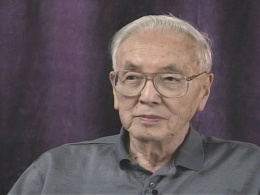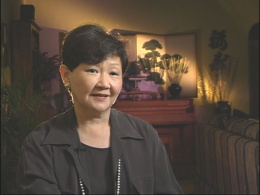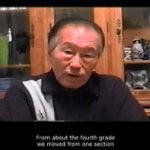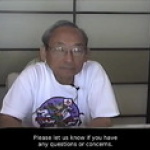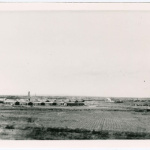Psychological effects of camp
Japanese Americans experienced a range of psychological effects related to their incarceration. These effects stemmed from multiple stressors that occurred over time. Some emerged soon after the bombing of Pearl Harbor. Others emerged during the incarceration itself, and still others extended decades after the war ended and the camps had closed.
Negative Psychological Effects
Shock, fear, and worry were common initial psychological reactions [1] as Japanese Americans were forced to deal with the stress of enforced dislocation and the abandonment of their homes, possessions, and businesses. Without information about where they were being taken, how they would be treated by the government, or how long they would be gone, uncertainty about their future loomed large. Added to these concerns was the larger psychological burden of being stripped of their civil rights and the unjust ethnic denigration of being suspected of disloyalty based only on their Japanese heritage [2] .
Within the camps, Japanese Americans endured dehumanizing conditions including poor housing and food, a lack of privacy, inadequate medical care, and substandard education. Feelings of helplessness emerged under the racially segregated colonial conditions where white administrators wielded power and set policy, and where Japanese Americans were treated more like prison inmates than individuals. [3] Many incarcerees attempted to make the best of their situation by responding with the Japanese stance "Shikata ga nai" (It can't be helped) and drawing upon the Japanese value of "gaman," the internalization of and suppression of emotion. [4] However, there was also anger and resentment about their unjust imprisonment. The "enforced idleness" and harsh living conditions aggravated tensions between incarcerees and the War Relocation Authority as well as among the incarcerees themselves as they argued about the distribution of camp resources and leadership positions. [5] Added to this were tensions surrounding responses to the government's loyalty questionnaire and the draft. Levels of disillusionment increased over time and approximately 20,000 incarcerees eventually expressed their frustration by filing for repatriation or expatriation to Japan. [6] Extreme peer pressure and coercion played a major role in the large number of requests, especially at the Tule Lake camp [7] and only about 8,000 actually left the country. Nonetheless, the large number who applied for this option has been seen as an indication of the levels of "outrage and alienation." [8]
More specific psychological effects of the incarceration were mediated by age, life stage, and gender. [9] The oldest incarcerees were first generation Japanese immigrants ( Issei ). Although most Issei had lived in the U.S. for decades, they were barred from citizenship in the U.S. (See Ozawa v. U.S. ) Those who were leaders in the Japanese American community before the war were considered by the government to be high risk for disloyalty. These 1,500, mostly male Issei, were abruptly arrested by the FBI soon after the attack on Pearl Harbor and kept in Department of Justice (DOJ) internment camps as enemy aliens. [10] DOJ internees experienced significant stress and worry from their sudden removal, loneliness at being separated from their families and friends for extended periods of time, and the clear loss of autonomy while imprisoned in highly controlled and Spartan conditions. [11] Given that most of these internees were active men who had been community leaders before their removal, these difficult conditions were felt intensely. [12] Those who were eventually moved to one of the ten incarceration camps encountered continued stress. Some found that their own children no longer recognized them. Others found themselves stigmatized by fellow incarcerees who viewed their previous DOJ detention with suspicion. [13]
The incarceration also had psychological impacts on the Issei in non-DOJ camps. Born and raised in Japan, "For the honor-conscious Issei, it was the repudiation of many years of effort and hard work in this country." [14] Under the communal camp conditions Issei men lost their traditional roles as the heads of household and civic leaders. In addition to losing their livelihoods and no longer being the primary wage-earners, they found that their wives, freed from household chores, could take on camp jobs for the same pay as men. [15] The absence of a home base and communal camp conditions diminished Issei authority within their own families. Children ate with peers rather than family members in the mess halls and frequently socialized with friends. [16] At the same time, the Issei experienced an additional loss of status as a result of WRA policy that prohibited them from taking on leadership positions at the beginning of the camps and instead placed the younger Nisei in those roles. [17]
Unlike their parents, the Nisei sons and daughters of the Issei were American-born U.S. citizens. The majority were in their early adolescence and twenties when they were incarcerated. [18] Their developmental stage as emerging adults in combination with their U.S. citizenship made them especially vulnerable to psychological effects. The incarceration was a serious attack on their American identity development [19] and had significant impact on Nisei self-image. Amy Iwasaki Mass [20] noted that, for the American-born Nisei, the government's treatment was a "betrayal by a trusted source" that led to "deep depression, a sense of shame, a sense of 'there must be something wrong with me.'" The psychological conflicts generated a "psychological uncertainty" [21] that extended well beyond the war. The feelings of humiliation and self-blame have been compared to those of victims of rape: even though they had done nothing to warrant incarceration, they felt that somehow they were responsible for being incarcerated. [22]
The oldest Nisei, who were just beginning their college education and careers before the war were among those most adversely affected and tend to have more negative recollections of camp than those who were children. [23] Yet, even those who were small children faced psychological challenges. Too young to fully comprehend their situation, they nonetheless experienced the harsh camp conditions, witnessed the humiliation of their parents, and sensed the feelings of shame associated with being Japanese. [24]
Postwar Impacts
The closing of the camps did not end the psychological impacts of the incarceration. Post-camp adjustment was difficult for many Issei. By the time the war ended, most Issei were too old to restart their careers and forced to depend on their children. In the most extreme cases, the anguish of being released from camp without the opportunity to regain work and lost sense of purpose led some to commit suicide. [25]
The Nisei faced additional psychological challenges during their resettlement after the war. Many struggled with the fact that they had been powerless to resist the injustice perpetrated upon them and wondered if somehow they, or Japanese Americans as a group, were responsible for their treatment. [26] Although post-incarceration responses among the Nisei varied, virtually all avoided discussing their wartime experience. [27] The detachment and avoidance of trauma-related stimuli demonstrated by the Nisei have been seen as paralleling symptoms of posttraumatic stress. [28] However, Tetsuden Kashima [29] referred to avoidance of discussion about the camps as a form of "social amnesia" that reflected not individual psychopathology, but rather a group attempt to suppress unpleasant memories and feelings. In addition to the silence about their incarceration, some Nisei also responded by distancing themselves from associating with other Japanese Americans and from anything related to Japan, in what has been seen as identification with the aggressor. [30] In contrast, others developed a distrust of white America and chose to associate only with other Japanese Americans.
Regardless of their socialization choices, the Nisei maintained a low profile to avoid calling negative attention to themselves and focused instead on fitting into American culture. [31] Mass [32] likened their response to an abused child who hopes that by acting correctly he will be accepted: "By trying to prove we were 110 percent American, we hoped to be accepted." The attempts of the Nisei to suppress their incarceration memories, blend in, and "prove" themselves to the country that had imprisoned them, however, took a psychological toll. Although precise data are not available, Mass [33] also observed that a prevalence psychosomatic disorders, peptic ulcers, and depression in the Nisei population, conditions that she considered to be negative effects of the psychological defenses they adopted.
The Niseis' postwar responses to the incarceration also had important intergenerational impacts for their Sansei children, the majority of whom were born after the war had ended. While the Sansei grew up hearing their parents refer to "camp" in indirect and cryptic ways (often as a reference point in time using phrases such as "before camp" and "after camp"), they experienced their parents' reluctance to fully discuss their incarceration experiences and sensed that what had happened was too painful to discuss. [34] The extended silence created a gap in the Sansei's own personal history and identity development, [35] and many carried feelings of sadness and anger about their parents' unspoken pain. The Sansei were also affected by the Niseis' efforts to blend into mainstream America and protect their children by minimizing the transmission of Japanese culture and language. As a result, most Sansei lost connection with much of their Japanese culture and language, experienced pressure to excel in academics and careers, and avoided doing anything that might draw negative attention.
Resilience and Positive Effects
While numerous negative psychological consequences are linked to the incarceration, there were positive effects as well. The resilience and strengths of Japanese Americans during this time were significant and reflected their resourcefulness and ability to make the best of their situation. Incarcerees constructed furniture and artwork out of lumber scraps and natural materials from around the camp, painted and drew what they observed, and demonstrated a remarkable capacity to portray beauty in their bleak surroundings. [36] (See Arts and crafts in camp .) Issei women, who had been released from meal preparation and domestic duties while in camp, benefited from increased free time and could pursue leisure activities such as flower arrangement, calligraphy, and wood carving. At the same time, Nisei women benefited by gaining camp work experience, experience that helped to increase their sense of independence and self-confidence." [37] Another unexpected positive effect was experienced by young Nisei men and women who were cleared to leave the camps before the war's end for work in areas of the Midwest or East. Although their transition was frightening and stressful, living far outside of their ethnic community broadened their views of the world and helped increase their self-confidence.
Despite the varied stresses encountered, Nisei relatives and friends provided support to each other during the camp years. [38] Many of those friendships endured throughout their adult lives. Similarly, the strong family bonds between the Issei and Nisei and cultural values that characterized prewar Japanese America helped incarcerees to buffer the strains of their imprisonment and resettlement and to work through the challenges that confronted their nuclear families. Resilience may also be seen in the fact that many Nisei went on to establish successful lives after the war despite the psychological burdens that have been noted. In turn, their resilience and that of the Issei positively affected the Sansei, who view their parents and grandparents as inspirational role models.
The incarceration has also sensitized Japanese Americans to issues of social justice. Knowing the hardships and injustices imposed on their parents and grandparents, the Sansei generation played a key role in resurrecting the topic of internment within their families and communities and worked together with Nisei and Issei on the redress movement . [39] Today, years after the successful redress effort, multiple generations of Japanese Americans remain watchful of policies and prejudices that unjustly target other groups.
For More Information
Children of the Camps: The Documentary . Video. Directed by Satsuki Ina and Steven Holsapple. San Francisco: National Asian American Telecommunications Association, 1999.
Harth, Erica. Last Witnesses: Reflections on the Wartime Internment of Japanese Americans . New York: Palgrave, 2001.
Mass, Amy I. "Psychological Effects of the Camps on Japanese Americans." In ' 'Japanese Americans: From Relocation to Redress (revised edition), edited by Roger Daniels, Sandra C. Taylor, and Harry H.L. Kitano, 159-162. Seattle: University of Washington Press, 1991.
Nagata, Donna K. Legacy of Injustice: Exploring the Cross-Generational Impact of the Japanese American Internment . New York: Plenum Press, 1993.
———. "Intergenerational Effects of the Japanese American Internment." In International Handbook of Multigenerational Legacies of Trauma , edited by Yael Danieli, 125-139. New York: Plenum Press, 1998.
Nagata, Donna K., and Yuzuru J. Takeshita. "Coping and Resilience across Generations: Japanese Americans and the World War II Internment." Psychoanalytic Review 85 (1998): 587-613.
Tateishi, John. And Justice for All: An Oral History of the Japanese Detention Camps . New York: Random House, 1984.
When You're Smiling: The Deadly Legacy of Internment . Video. Directed by Janice D. Tanaka. Los Angeles: Visual Communications, 1999.
Yoo, David K. Growing up Nisei: Race, Generation, and Culture among Japanese Americans of California, 1924-49 . Urbana & Chicago, IL: University of Illinois Press, 1984.
Footnotes
- ↑ Donna K. Nagata, Wendy J.Y. Cheng, and Teresa U. Nguyen, "Recollections of Historical Injustice: A Qualitative Investigation of Emotions in Japanese American Incarceration Memories," in Qualitative Strategies for Ethnocultural Research , ed. Donna K. Nagata et al. (Washington D.C.: American Psychological Association, 2012), 107.
- ↑ Chalsa M. Loo, "An Integrative-Sequential Treatment Model for Posttraumatic Stress Disorder: A Case Study of the Japanese American Internment and Redress," Clinical Psychology Review 13 (1993), 100.
- ↑ Harry H.L. Kitano, "The Effects of the Evacuation on the Japanese Americans," in Japanese Americans: From Relocation to Redress (revised edition.), eds. Roger Daniels, et al. (Seattle: University of Washington Press, 1991), 154.
- ↑ Harry H.L. Kitano, Japanese Americans: The Evolution of a Subculture (Englewood Cliffs, NJ: Prentice-Hall, 1969), 109.
- ↑ Commission on Wartime Relocation and Internment of Civilians, Personal Justice Denied: Report of the Commission on Wartime Relocation and Internment of Civilians (Washington D.C.: Civil Liberties Public Education Fund and Seattle: University of Washington Press, 1997), 177.
- ↑ Personal Justice Denied , 251.
- ↑ Ibid., 250.
- ↑ Ibid., 252.
- ↑ Stephen S. Fugita and Marilyn Fernandez, Altered Lives, Enduring Community: Japanese Americans Remember Their World War II Incarceration (Seattle: University of Washington Press, 2004), 199; Donna K. Nagata, "Coping and Resilience Across Generations: Japanese Americans and the World War II Internment," Psychoanalytic Review 85 (1998), 593-595.
- ↑ Roger Daniels, Prisoners Without Trial: Japanese Americans in World War II (New York: Hill and Wang, 1993), 26.
- ↑ John J. Culley, "The Santa Fe Internment Camp and the Justice Department Program for Enemy Aliens," in Japanese Americans: From Relocation to Redress (revised edition), eds. Roger Daniels, et al. (Seattle: University of Washington Press, 1991), 60.
- ↑ Tetsuden Kashima, "American Mistreatment of Internees During World War II: Enemy Alien Japanese," in Japanese Americans: From Relocation to Redress (revised edition), eds. Roger Daniels, et al. (Seattle: University of Washington Press, 1991), 55.
- ↑ Fugita and Fernandez, Altered Lives, Enduring Community , 136.
- ↑ Amy I. Mass, "Psychological Effects of the Camps on Japanese Americans," in Japanese Americans: From Relocation to Redress (revised edition), eds. Roger Daniels, et al. (Seattle: University of Washington Press, 1991), 160.
- ↑ Leonard Broom and John I. Kitsuse, The Managed Casualty: The Japanese-American Family During World War II (Berkeley: University of California Press, 1956), 36-41; Valerie Matsumoto, "Japanese American Women During World War II," Frontiers VIII (1984): 9.
- ↑ Kitano, "The Effects of the Evacuation," 155; James K. Morishima, "The Evacuation: Impact on the Family," in Asian Americans: Psychological Perspectives , eds. Stanley Sue and Nathan N. Wagner (Palo Alto, CA: Science and Behavior Books, 1973), 15; Mei Nakano, Japanese American Women: Three Generations 1890-1990 (Berkeley, CA: Mina Press, 1990), 147.
- ↑ Personal Justice Denied , 177.
- ↑ David Yoo, Growing Up Nisei: Race, Generation, and Culture among Japanese Americans of California, 1924-49 (Urbana: University of Illinois Press, 2000), 3.
- ↑ Fugita and Fernandez, Altered Lives , 207.
- ↑ Mass, "Psychological Effects of the Camps," 160.
- ↑ Fugita and Fernandez, Altered Lives , 112-113.
- ↑ Arthur A. Hansen, and Betty E. Mitson, Voices Long Silent: An Oral Inquiry into the Japanese American Evacuation (Fullerton: Japanese American Project of the Oral History Program at California State University, 1974), 14.
- ↑ Fugita and Fernandez, Altered Lives , 62.
- ↑ John Tateishi, "Memories from Behind Barbed Wire," in Last Witnesses: Reflections on the Wartime Internment of Japanese Americans , ed. Erica Harth (New York: Palgrave, 2001), 131-132.
- ↑ Gwendolyn M. Jensen, "The Experience of Injustice: Health Consequences of the Japanese American Internment" Ph.D. diss., University of Colorado, 1997.
- ↑ Fugita and Fernandez, Altered Lives , 112; S. Frank Miyamoto, "Problems of Interpersonal Style among the Nisei," Amerasia Journal 13, (1986-87): 29-45; Donna K. Nagata, Legacy of Injustice: Exploring the Cross-Generational Impact of the Japanese American Internment (New York: Plenum, 1993), 26-35.
- ↑ Personal Justice Denied , 299.
- ↑ Loo, "An Integrative-Sequential Treatment," 103.
- ↑ Tetsuden Kashima, "Japanese American Internees: Return, 1945-1955: Readjustment and Social Amnesia," Phylon 41.2 (1980), 113.
- ↑ Personal Justice Denied , 299; Mass, "Psychological Effects of the Camps," 160.
- ↑ Kenji Ima, "Japanese Americans: The Making of "Good" People," in The Minority Report: An Introduction to Racial, Ethnic, and Gender Relations , eds. Anthony G. Dworkin and Rosalind J. Dworkin (New York: Praeger, 1976), 275.
- ↑ Mass, "Psychological Effects of the Camps," 161.
- ↑ Amy I. Mass, "Asians as Individuals: the Japanese Community," Social Casework (March 1976), 163.
- ↑ Nagata, Legacy of Injustice , 75-102.
- ↑ Nobu Miyoshi, "Identity Crisis of the Sansei and the American Concentration Camp," Pacific Citizen , December 19-26, 1980, 41, 42, 50, 55.
- ↑ Deborah Gesensway and Mindy Roseman, Beyond Words: Images from America's Concentration Camps (Ithaca: Cornell University Press, 1987); Toyo Suyemoto, "Another Spring," in Last Witnesses: Reflections on the Wartime Internment of Japanese Americans , ed. Erica Harth (New York: Palgrave, 2001), 21.
- ↑ Matsumoto, "Japanese American Women during World War II," 9-10; Mei Nakano, Japanese American Women , 63.
- ↑ Matsumoto, "Japanese American Women," 12.
- ↑ Donald. T. Nakanishi, "Seeking Convergence in Race Relations Research: Japanese Americans and the Resurrection of the Internment," in Eliminating Racism: Profiles in Controversy , eds. Phyllis A. Katz and Dalmas A. Taylor (New York: Plenum Press, 1988), 169.
Last updated July 22, 2020, 3:41 p.m..

 Media
Media
